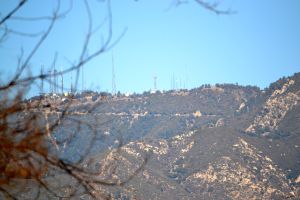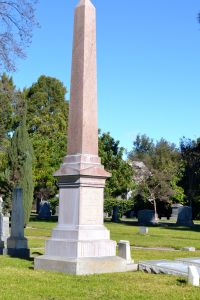It’s been more of a challenge to tell the local story of General George S. Patton than I had previously thought. I think it would be easier if I had one of those enormous war room strategy maps to plot out the Patton family history. Sometimes I have trouble keeping all the characters straight. It doesn’t help that some of the history books hold contradictory information.
I started my original questioning with a trip to the San Gabriel Cemetery.
I’m not intending to add much color to the General’s illustrious life, at least in terms of his military career. A general call “Old Blood and Guts”–a nickname he hated but his men loved, is a biographer’s dream. There is much written. Known for his explosive temper and shall-we-say colorful language, he was a leader for which myths and truth have mingled and persisted despite his death 67 years ago.
But there was a reason I decided to finally read a personal history of the Patton family. General Patton and his wife are buried in Luxembourg, but his grandparents, parents, sister and a few other family members I haven’t yet researched are buried half a mile from my home. When growing up I had always heard that Patton was born in neighboring Alhambra. In recent years, the city of San Marino has claimed him as their native son.
I assumed a kernel of truth was contained in each story.
Let’s start with the name.
The first George Smith Patton, the General’s grandfather, was a colonel in the Confederate States Army, killed at the Battle of Opequon. His son, born George William Patton, changed his name to George Smith Patton in honor of his father. Though given the name Junior, General George S. Patton was actually the third George Smith Patton.
But to get down to where was Patton born? My research says San Gabriel can claim him! Sort of…
Some of the records indicate he was born in “San Gabriel Township.” That term caught my interest. I’ve never heard that before.
Patton’s maternal grandparents were Benjamin Davis Wilson and his second wife Margaret Hereford. The Wilson name is very well-known in Southern California.
Benjamin Davis Wilson was a California statesman and politician. In 1851, Wilson was the second elected mayor of Los Angeles after California was made a state. Wilson’s name cropped up when I was studying early Los Angeles and the Water Wars, but I hadn’t yet made the connection to Patton.
There are many stories which describe Wilson as another very colorful and adventure-seeking man. He was also known for his kind treatment of the Spanish Native Americans. Don Benito, as he was called, became the first non-Hispanic owner of what was then Rancho San Pascual, which includes today’s towns of Pasadena, Altadena, South Pasadena, Alhambra, San Marino, and San Gabriel.
You’ll have to take it from me that this was a very large Rancho.
I mentioned the Wilson name has a strong recognition factor. Yes, indeed! Mount Wilson, a notable peak in the San Gabriel Mountains is where the majority of television and radio transmission towers for the greater Los Angeles area stands as a monument to the man who took the first white man’s expedition to the peak hoping to harvest timber for making wine vats. The wood was of inferior quality for that purpose, but the Wilson Trail remains one of the most popular hikes to the crest of the San Gabriel Mountains.
I wonder how many Southern Californian’s know that Mount Wilson was named after General George Patton’s grandfather?
I couldn’t help but notice a clear view of Mount Wilson taken from the foot of the Wilson/Patton burial plot. The large marble obelisk measures almost 25 feet in height and is inscribed with the Wilson name. Looking north from that spot the television and radio transmission towers are easily visible.
Wilson did live out his days in what is present-day San Gabriel and after that, understanding the property divisions gets complicated. I think it’s safe to say that each of the cities has a reasonable claim on some portion of the Patton family history.
Next to the cemetery, on what was once Wilson land, is one of the prettiest little churches in the area, the Episcopal Church of Our Savior. The General’s family were long time members and benefactors of the church, first built in 1867 with adobe and hand-made nails. It is told that Patton was baptized in this parish.
A beautiful bronze statue of General George S. Patton stands with his side arm in a dedicated space between the cemetery and the church.
But like I said, other cities claim him, too. So next post I’ll share another San Marino bronze and perhaps get a little deeper into the local history. There’s the arroyo which passes under the Rose Bowl and was once called Wilson’s Ditch, bringing water to the valley long before Mulholland and the infamous aqueduct, and I think I’ve figured out where the Patton family home was, right around the corner from the Huntington Library.
Wish me luck. You know I can get in trouble with my camera and private property.
Stay tuned…









